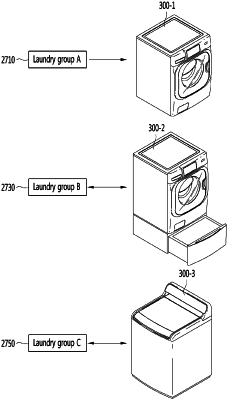| CPC D06F 33/32 (2020.02) [D06F 34/18 (2020.02); D06F 34/28 (2020.02); G06F 3/16 (2013.01); G06F 18/2148 (2023.01); G06N 3/008 (2013.01); G06V 10/82 (2022.01)] | 13 Claims |

|
1. An artificial intelligence (AI)-based laundry treatment apparatus comprising:
a camera;
a washing module;
a memory for storing therein a laundry recognition model, wherein the laundry recognition model is trained using a machine learning or deep learning algorithm, wherein the laundry recognition model is configured to recognize laundry information about laundry; and
a processor configured to:
apply image data from an image, captured by the camera, of each of a plurality of laundry to the laundry recognition model to acquire the laundry information including a mixed ratio of each material of the laundry, a handling instruction of the laundry, and an appropriate washing temperature of the laundry;
extract a plurality of material information values from the acquired laundry information to obtain a vector for each of the plurality of laundry;
generate values for a data set corresponding to a plurality of laundry handling images of the acquired laundry information for each of the plurality of laundry, wherein each of the plurality of laundry handling images indicates handling precaution;
generate encoding data for each of the plurality of laundry based on the obtained vector and the data set;
acquire values of laundry control variables corresponding to the encoding data for each of the plurality of laundry using a trained laundry course learning model, wherein the values of laundry control variable are used to generate a laundry course for the washing module; and
control the washing module to perform cleaning with the generated laundry course corresponding to the acquired values of the laundry control variables,
wherein the processor is further configured to:
compare the plurality of laundry handling images with per-material laundry handling information that indicates a handling method of each material; and
generate the values for the data set based on a result of the comparison.
|